Foreign Exchange Hedging Strategies
VerifiedAdded on 2021/02/22
|8
|1720
|69
AI Summary
This assignment provides a thorough evaluation of different foreign exchange hedging methods, focusing on the money market hedge and historical simulation method. It discusses the advantages and disadvantages of each approach, recommending the money market hedge as more suitable due to its flexibility and customization options. The study emphasizes the importance of hedging in minimizing foreign exchange losses and making effective investment decisions.
Contribute Materials
Your contribution can guide someone’s learning journey. Share your
documents today.

Project
Secure Best Marks with AI Grader
Need help grading? Try our AI Grader for instant feedback on your assignments.
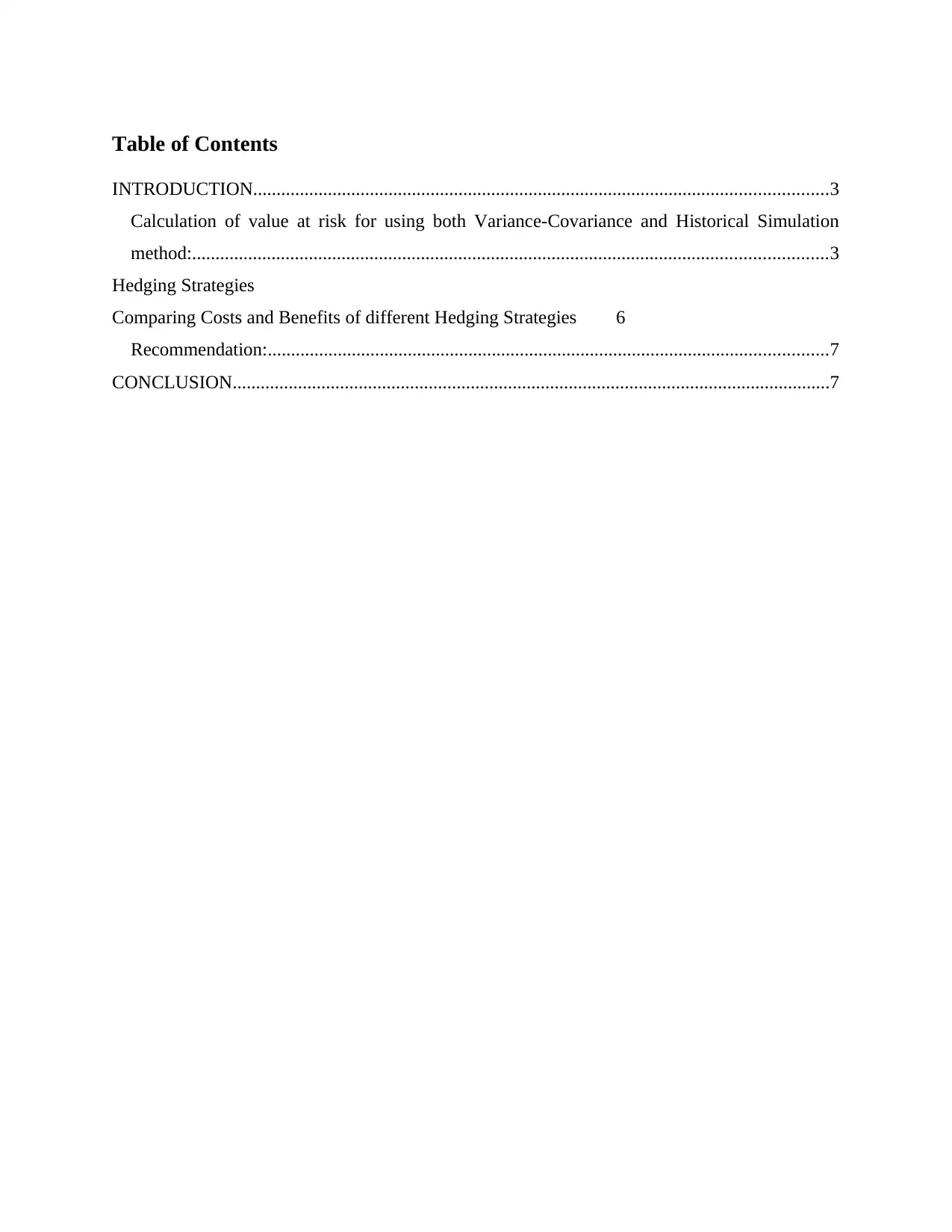
Table of Contents
INTRODUCTION...........................................................................................................................3
Calculation of value at risk for using both Variance-Covariance and Historical Simulation
method:........................................................................................................................................3
Hedging Strategies
Comparing Costs and Benefits of different Hedging Strategies 6
Recommendation:........................................................................................................................7
CONCLUSION................................................................................................................................7
INTRODUCTION...........................................................................................................................3
Calculation of value at risk for using both Variance-Covariance and Historical Simulation
method:........................................................................................................................................3
Hedging Strategies
Comparing Costs and Benefits of different Hedging Strategies 6
Recommendation:........................................................................................................................7
CONCLUSION................................................................................................................................7
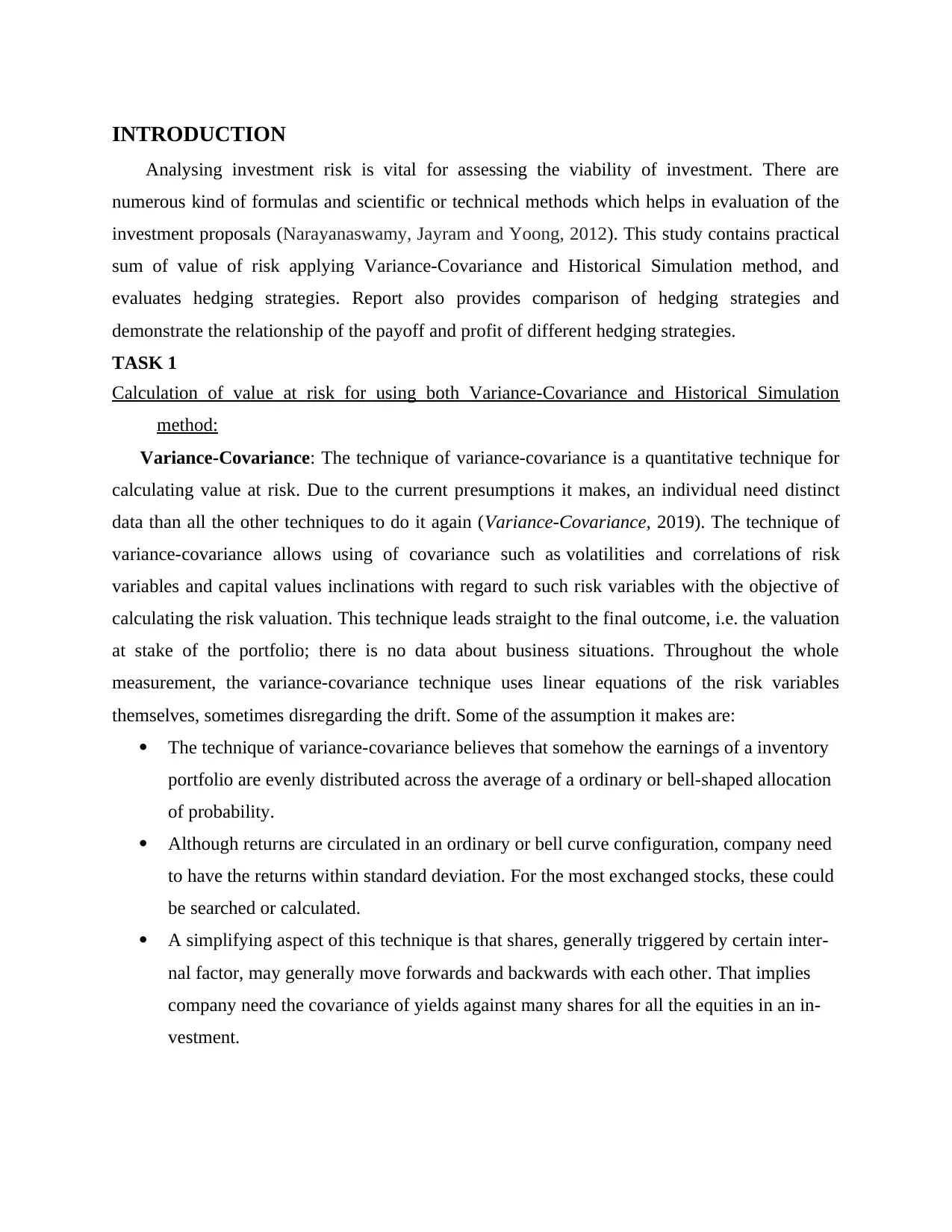
INTRODUCTION
Analysing investment risk is vital for assessing the viability of investment. There are
numerous kind of formulas and scientific or technical methods which helps in evaluation of the
investment proposals (Narayanaswamy, Jayram and Yoong, 2012). This study contains practical
sum of value of risk applying Variance-Covariance and Historical Simulation method, and
evaluates hedging strategies. Report also provides comparison of hedging strategies and
demonstrate the relationship of the payoff and profit of different hedging strategies.
TASK 1
Calculation of value at risk for using both Variance-Covariance and Historical Simulation
method:
Variance-Covariance: The technique of variance-covariance is a quantitative technique for
calculating value at risk. Due to the current presumptions it makes, an individual need distinct
data than all the other techniques to do it again (Variance-Covariance, 2019). The technique of
variance-covariance allows using of covariance such as volatilities and correlations of risk
variables and capital values inclinations with regard to such risk variables with the objective of
calculating the risk valuation. This technique leads straight to the final outcome, i.e. the valuation
at stake of the portfolio; there is no data about business situations. Throughout the whole
measurement, the variance-covariance technique uses linear equations of the risk variables
themselves, sometimes disregarding the drift. Some of the assumption it makes are:
The technique of variance-covariance believes that somehow the earnings of a inventory
portfolio are evenly distributed across the average of a ordinary or bell-shaped allocation
of probability.
Although returns are circulated in an ordinary or bell curve configuration, company need
to have the returns within standard deviation. For the most exchanged stocks, these could
be searched or calculated.
A simplifying aspect of this technique is that shares, generally triggered by certain inter-
nal factor, may generally move forwards and backwards with each other. That implies
company need the covariance of yields against many shares for all the equities in an in-
vestment.
Analysing investment risk is vital for assessing the viability of investment. There are
numerous kind of formulas and scientific or technical methods which helps in evaluation of the
investment proposals (Narayanaswamy, Jayram and Yoong, 2012). This study contains practical
sum of value of risk applying Variance-Covariance and Historical Simulation method, and
evaluates hedging strategies. Report also provides comparison of hedging strategies and
demonstrate the relationship of the payoff and profit of different hedging strategies.
TASK 1
Calculation of value at risk for using both Variance-Covariance and Historical Simulation
method:
Variance-Covariance: The technique of variance-covariance is a quantitative technique for
calculating value at risk. Due to the current presumptions it makes, an individual need distinct
data than all the other techniques to do it again (Variance-Covariance, 2019). The technique of
variance-covariance allows using of covariance such as volatilities and correlations of risk
variables and capital values inclinations with regard to such risk variables with the objective of
calculating the risk valuation. This technique leads straight to the final outcome, i.e. the valuation
at stake of the portfolio; there is no data about business situations. Throughout the whole
measurement, the variance-covariance technique uses linear equations of the risk variables
themselves, sometimes disregarding the drift. Some of the assumption it makes are:
The technique of variance-covariance believes that somehow the earnings of a inventory
portfolio are evenly distributed across the average of a ordinary or bell-shaped allocation
of probability.
Although returns are circulated in an ordinary or bell curve configuration, company need
to have the returns within standard deviation. For the most exchanged stocks, these could
be searched or calculated.
A simplifying aspect of this technique is that shares, generally triggered by certain inter-
nal factor, may generally move forwards and backwards with each other. That implies
company need the covariance of yields against many shares for all the equities in an in-
vestment.
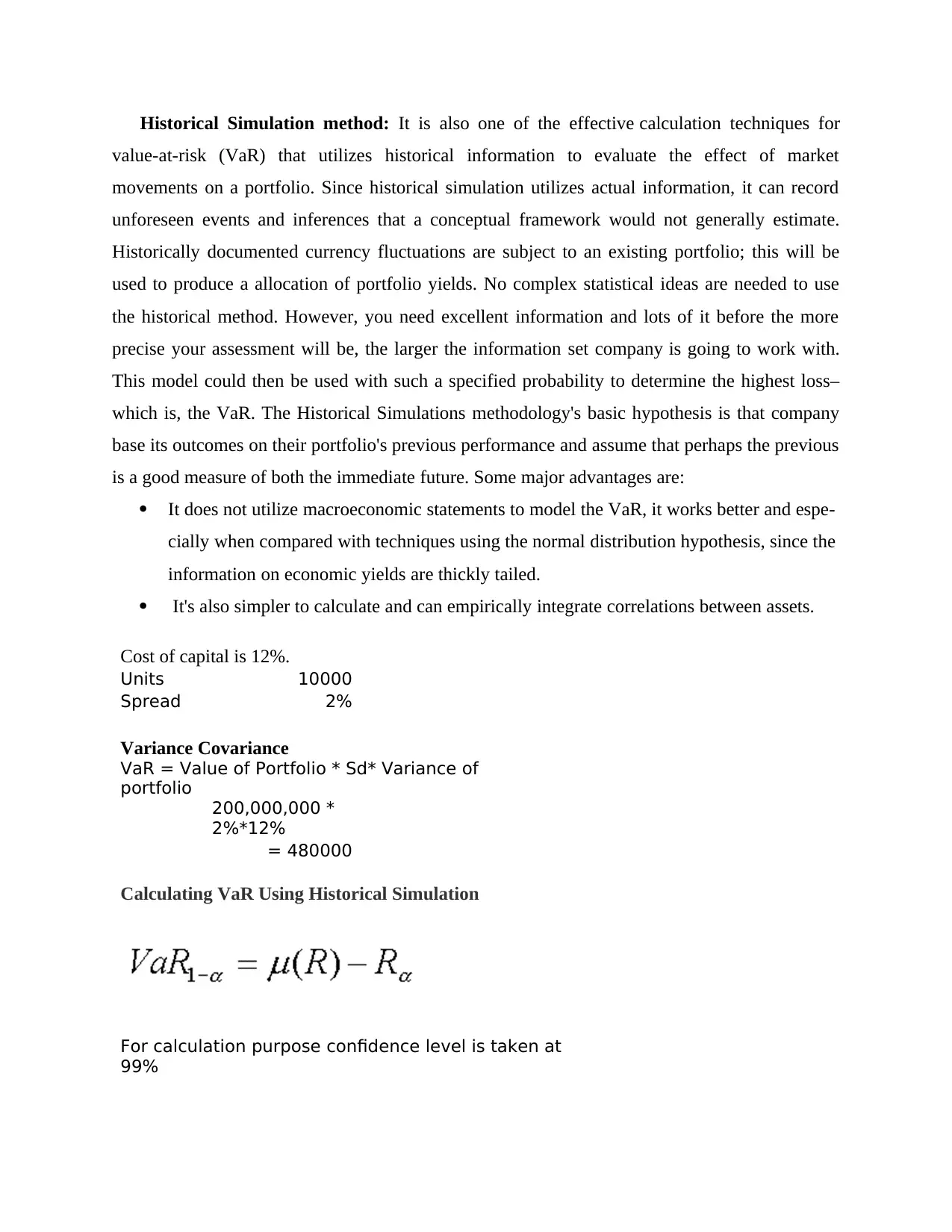
Historical Simulation method: It is also one of the effective calculation techniques for
value-at-risk (VaR) that utilizes historical information to evaluate the effect of market
movements on a portfolio. Since historical simulation utilizes actual information, it can record
unforeseen events and inferences that a conceptual framework would not generally estimate.
Historically documented currency fluctuations are subject to an existing portfolio; this will be
used to produce a allocation of portfolio yields. No complex statistical ideas are needed to use
the historical method. However, you need excellent information and lots of it before the more
precise your assessment will be, the larger the information set company is going to work with.
This model could then be used with such a specified probability to determine the highest loss–
which is, the VaR. The Historical Simulations methodology's basic hypothesis is that company
base its outcomes on their portfolio's previous performance and assume that perhaps the previous
is a good measure of both the immediate future. Some major advantages are:
It does not utilize macroeconomic statements to model the VaR, it works better and espe-
cially when compared with techniques using the normal distribution hypothesis, since the
information on economic yields are thickly tailed.
It's also simpler to calculate and can empirically integrate correlations between assets.
Cost of capital is 12%.
Units 10000
Spread 2%
Variance Covariance
VaR = Value of Portfolio * Sd* Variance of
portfolio
200,000,000 *
2%*12%
= 480000
Calculating VaR Using Historical Simulation
For calculation purpose confidence level is taken at
99%
value-at-risk (VaR) that utilizes historical information to evaluate the effect of market
movements on a portfolio. Since historical simulation utilizes actual information, it can record
unforeseen events and inferences that a conceptual framework would not generally estimate.
Historically documented currency fluctuations are subject to an existing portfolio; this will be
used to produce a allocation of portfolio yields. No complex statistical ideas are needed to use
the historical method. However, you need excellent information and lots of it before the more
precise your assessment will be, the larger the information set company is going to work with.
This model could then be used with such a specified probability to determine the highest loss–
which is, the VaR. The Historical Simulations methodology's basic hypothesis is that company
base its outcomes on their portfolio's previous performance and assume that perhaps the previous
is a good measure of both the immediate future. Some major advantages are:
It does not utilize macroeconomic statements to model the VaR, it works better and espe-
cially when compared with techniques using the normal distribution hypothesis, since the
information on economic yields are thickly tailed.
It's also simpler to calculate and can empirically integrate correlations between assets.
Cost of capital is 12%.
Units 10000
Spread 2%
Variance Covariance
VaR = Value of Portfolio * Sd* Variance of
portfolio
200,000,000 *
2%*12%
= 480000
Calculating VaR Using Historical Simulation
For calculation purpose confidence level is taken at
99%
Secure Best Marks with AI Grader
Need help grading? Try our AI Grader for instant feedback on your assignments.
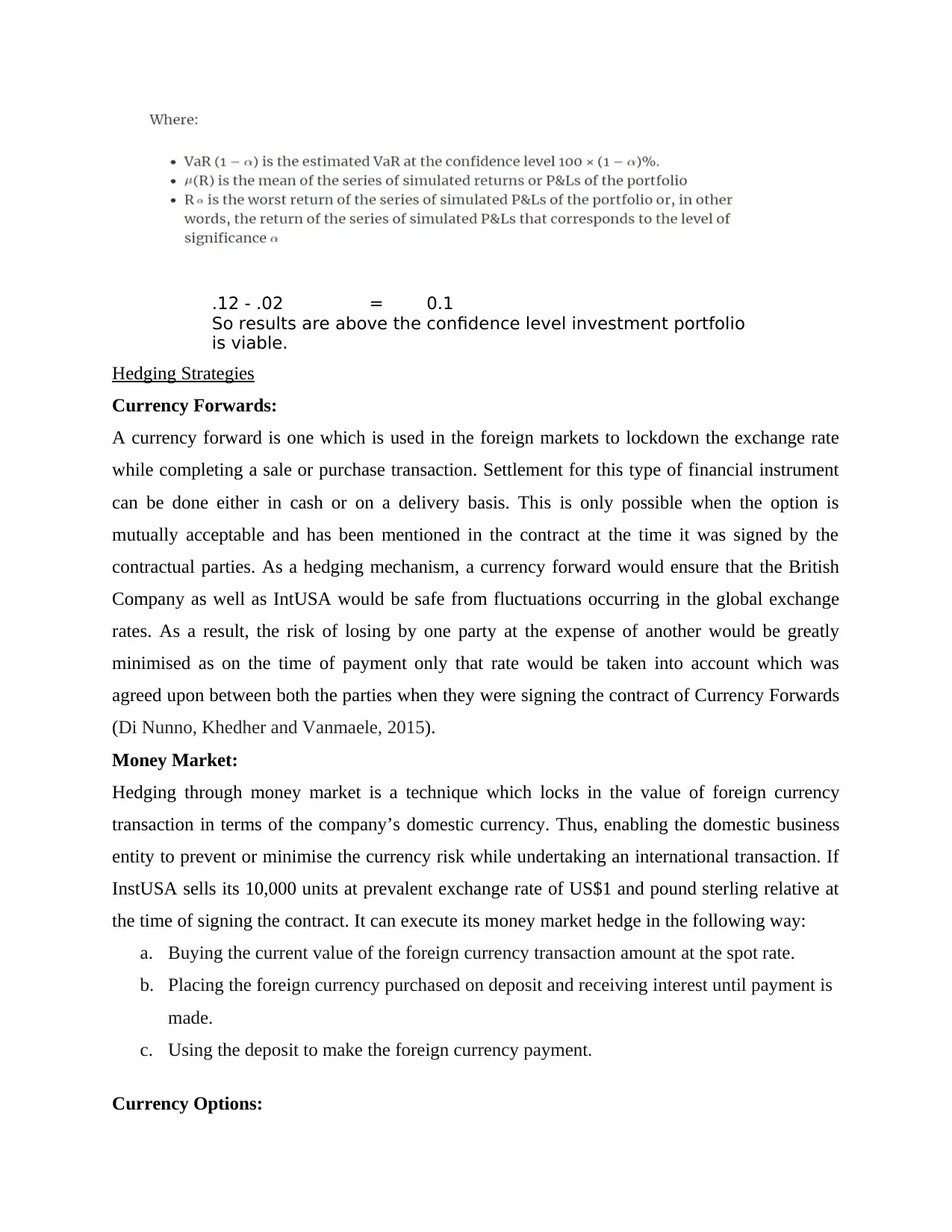
.12 - .02 = 0.1
So results are above the confidence level investment portfolio
is viable.
Hedging Strategies
Currency Forwards:
A currency forward is one which is used in the foreign markets to lockdown the exchange rate
while completing a sale or purchase transaction. Settlement for this type of financial instrument
can be done either in cash or on a delivery basis. This is only possible when the option is
mutually acceptable and has been mentioned in the contract at the time it was signed by the
contractual parties. As a hedging mechanism, a currency forward would ensure that the British
Company as well as IntUSA would be safe from fluctuations occurring in the global exchange
rates. As a result, the risk of losing by one party at the expense of another would be greatly
minimised as on the time of payment only that rate would be taken into account which was
agreed upon between both the parties when they were signing the contract of Currency Forwards
(Di Nunno, Khedher and Vanmaele, 2015).
Money Market:
Hedging through money market is a technique which locks in the value of foreign currency
transaction in terms of the company’s domestic currency. Thus, enabling the domestic business
entity to prevent or minimise the currency risk while undertaking an international transaction. If
InstUSA sells its 10,000 units at prevalent exchange rate of US$1 and pound sterling relative at
the time of signing the contract. It can execute its money market hedge in the following way:
a. Buying the current value of the foreign currency transaction amount at the spot rate.
b. Placing the foreign currency purchased on deposit and receiving interest until payment is
made.
c. Using the deposit to make the foreign currency payment.
Currency Options:
So results are above the confidence level investment portfolio
is viable.
Hedging Strategies
Currency Forwards:
A currency forward is one which is used in the foreign markets to lockdown the exchange rate
while completing a sale or purchase transaction. Settlement for this type of financial instrument
can be done either in cash or on a delivery basis. This is only possible when the option is
mutually acceptable and has been mentioned in the contract at the time it was signed by the
contractual parties. As a hedging mechanism, a currency forward would ensure that the British
Company as well as IntUSA would be safe from fluctuations occurring in the global exchange
rates. As a result, the risk of losing by one party at the expense of another would be greatly
minimised as on the time of payment only that rate would be taken into account which was
agreed upon between both the parties when they were signing the contract of Currency Forwards
(Di Nunno, Khedher and Vanmaele, 2015).
Money Market:
Hedging through money market is a technique which locks in the value of foreign currency
transaction in terms of the company’s domestic currency. Thus, enabling the domestic business
entity to prevent or minimise the currency risk while undertaking an international transaction. If
InstUSA sells its 10,000 units at prevalent exchange rate of US$1 and pound sterling relative at
the time of signing the contract. It can execute its money market hedge in the following way:
a. Buying the current value of the foreign currency transaction amount at the spot rate.
b. Placing the foreign currency purchased on deposit and receiving interest until payment is
made.
c. Using the deposit to make the foreign currency payment.
Currency Options:
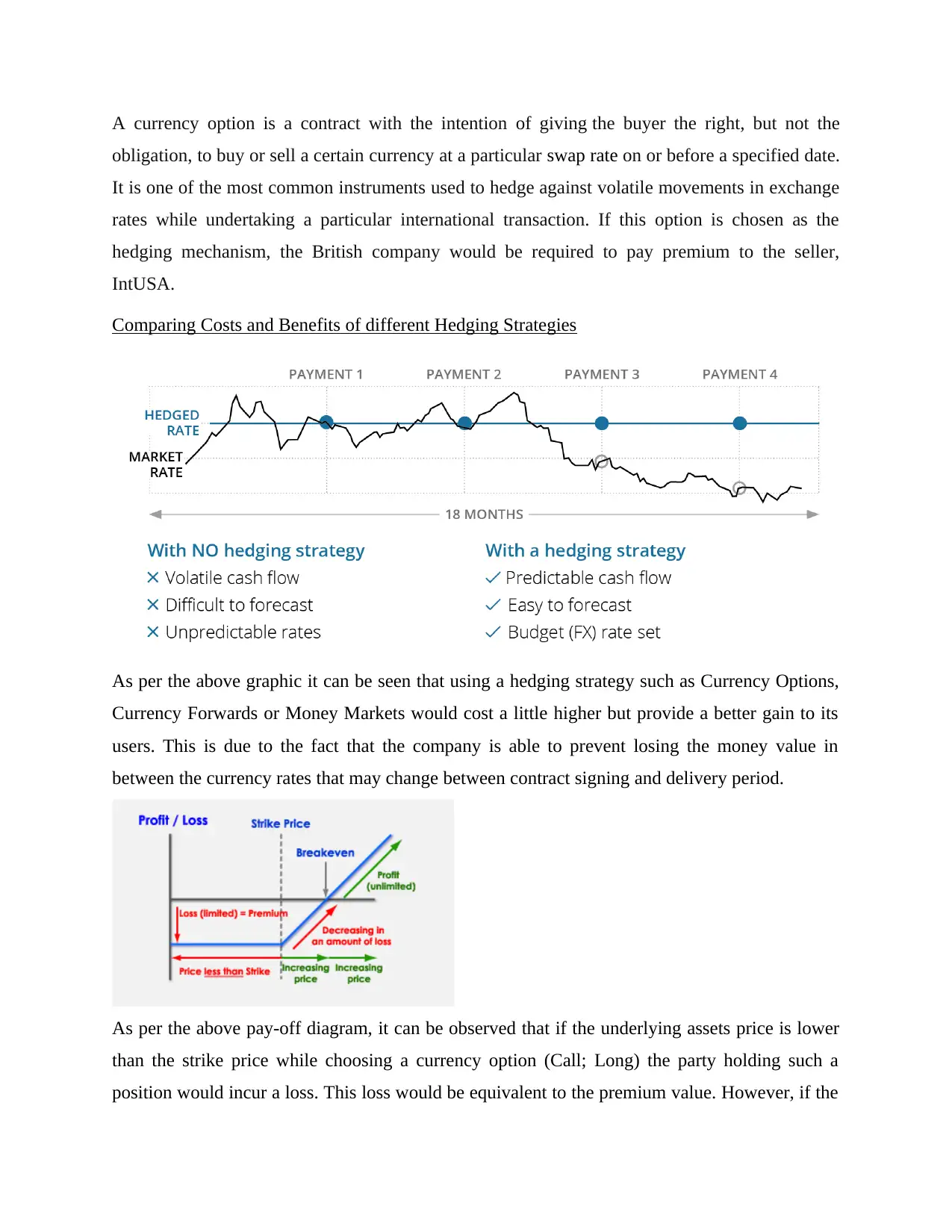
A currency option is a contract with the intention of giving the buyer the right, but not the
obligation, to buy or sell a certain currency at a particular swap rate on or before a specified date.
It is one of the most common instruments used to hedge against volatile movements in exchange
rates while undertaking a particular international transaction. If this option is chosen as the
hedging mechanism, the British company would be required to pay premium to the seller,
IntUSA.
Comparing Costs and Benefits of different Hedging Strategies
As per the above graphic it can be seen that using a hedging strategy such as Currency Options,
Currency Forwards or Money Markets would cost a little higher but provide a better gain to its
users. This is due to the fact that the company is able to prevent losing the money value in
between the currency rates that may change between contract signing and delivery period.
As per the above pay-off diagram, it can be observed that if the underlying assets price is lower
than the strike price while choosing a currency option (Call; Long) the party holding such a
position would incur a loss. This loss would be equivalent to the premium value. However, if the
obligation, to buy or sell a certain currency at a particular swap rate on or before a specified date.
It is one of the most common instruments used to hedge against volatile movements in exchange
rates while undertaking a particular international transaction. If this option is chosen as the
hedging mechanism, the British company would be required to pay premium to the seller,
IntUSA.
Comparing Costs and Benefits of different Hedging Strategies
As per the above graphic it can be seen that using a hedging strategy such as Currency Options,
Currency Forwards or Money Markets would cost a little higher but provide a better gain to its
users. This is due to the fact that the company is able to prevent losing the money value in
between the currency rates that may change between contract signing and delivery period.
As per the above pay-off diagram, it can be observed that if the underlying assets price is lower
than the strike price while choosing a currency option (Call; Long) the party holding such a
position would incur a loss. This loss would be equivalent to the premium value. However, if the
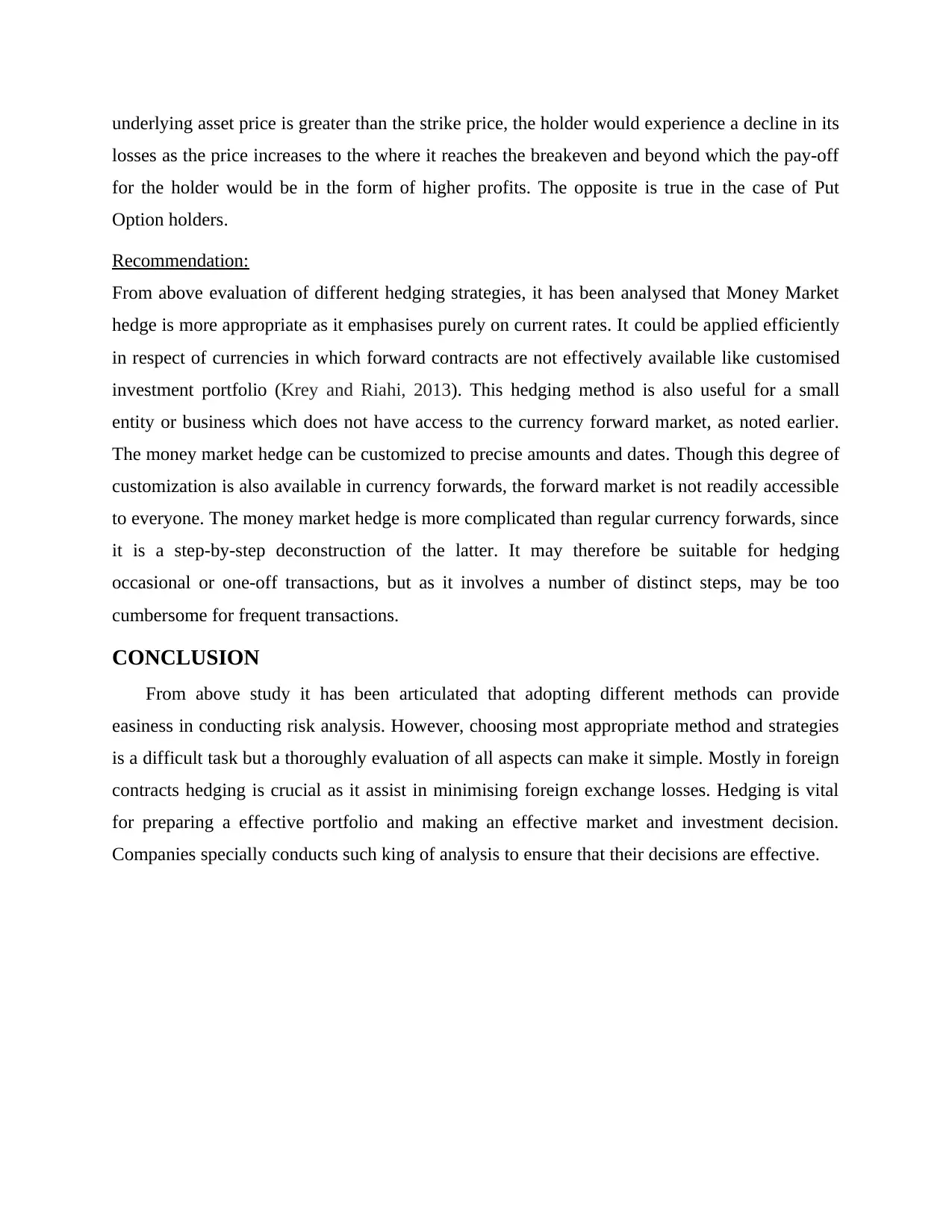
underlying asset price is greater than the strike price, the holder would experience a decline in its
losses as the price increases to the where it reaches the breakeven and beyond which the pay-off
for the holder would be in the form of higher profits. The opposite is true in the case of Put
Option holders.
Recommendation:
From above evaluation of different hedging strategies, it has been analysed that Money Market
hedge is more appropriate as it emphasises purely on current rates. It could be applied efficiently
in respect of currencies in which forward contracts are not effectively available like customised
investment portfolio (Krey and Riahi, 2013). This hedging method is also useful for a small
entity or business which does not have access to the currency forward market, as noted earlier.
The money market hedge can be customized to precise amounts and dates. Though this degree of
customization is also available in currency forwards, the forward market is not readily accessible
to everyone. The money market hedge is more complicated than regular currency forwards, since
it is a step-by-step deconstruction of the latter. It may therefore be suitable for hedging
occasional or one-off transactions, but as it involves a number of distinct steps, may be too
cumbersome for frequent transactions.
CONCLUSION
From above study it has been articulated that adopting different methods can provide
easiness in conducting risk analysis. However, choosing most appropriate method and strategies
is a difficult task but a thoroughly evaluation of all aspects can make it simple. Mostly in foreign
contracts hedging is crucial as it assist in minimising foreign exchange losses. Hedging is vital
for preparing a effective portfolio and making an effective market and investment decision.
Companies specially conducts such king of analysis to ensure that their decisions are effective.
losses as the price increases to the where it reaches the breakeven and beyond which the pay-off
for the holder would be in the form of higher profits. The opposite is true in the case of Put
Option holders.
Recommendation:
From above evaluation of different hedging strategies, it has been analysed that Money Market
hedge is more appropriate as it emphasises purely on current rates. It could be applied efficiently
in respect of currencies in which forward contracts are not effectively available like customised
investment portfolio (Krey and Riahi, 2013). This hedging method is also useful for a small
entity or business which does not have access to the currency forward market, as noted earlier.
The money market hedge can be customized to precise amounts and dates. Though this degree of
customization is also available in currency forwards, the forward market is not readily accessible
to everyone. The money market hedge is more complicated than regular currency forwards, since
it is a step-by-step deconstruction of the latter. It may therefore be suitable for hedging
occasional or one-off transactions, but as it involves a number of distinct steps, may be too
cumbersome for frequent transactions.
CONCLUSION
From above study it has been articulated that adopting different methods can provide
easiness in conducting risk analysis. However, choosing most appropriate method and strategies
is a difficult task but a thoroughly evaluation of all aspects can make it simple. Mostly in foreign
contracts hedging is crucial as it assist in minimising foreign exchange losses. Hedging is vital
for preparing a effective portfolio and making an effective market and investment decision.
Companies specially conducts such king of analysis to ensure that their decisions are effective.
Paraphrase This Document
Need a fresh take? Get an instant paraphrase of this document with our AI Paraphraser
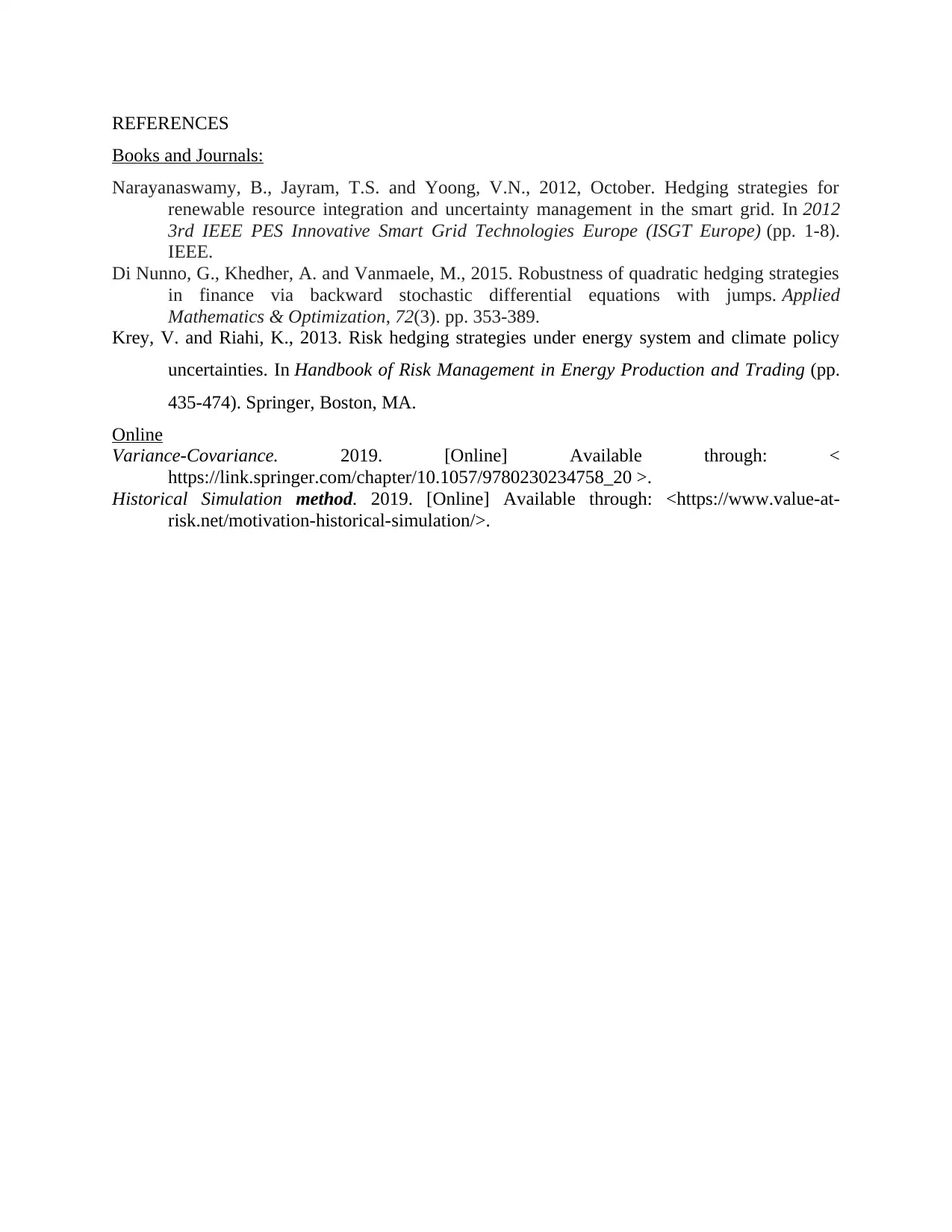
REFERENCES
Books and Journals:
Narayanaswamy, B., Jayram, T.S. and Yoong, V.N., 2012, October. Hedging strategies for
renewable resource integration and uncertainty management in the smart grid. In 2012
3rd IEEE PES Innovative Smart Grid Technologies Europe (ISGT Europe) (pp. 1-8).
IEEE.
Di Nunno, G., Khedher, A. and Vanmaele, M., 2015. Robustness of quadratic hedging strategies
in finance via backward stochastic differential equations with jumps. Applied
Mathematics & Optimization, 72(3). pp. 353-389.
Krey, V. and Riahi, K., 2013. Risk hedging strategies under energy system and climate policy
uncertainties. In Handbook of Risk Management in Energy Production and Trading (pp.
435-474). Springer, Boston, MA.
Online
Variance-Covariance. 2019. [Online] Available through: <
https://link.springer.com/chapter/10.1057/9780230234758_20 >.
Historical Simulation method. 2019. [Online] Available through: <https://www.value-at-
risk.net/motivation-historical-simulation/>.
Books and Journals:
Narayanaswamy, B., Jayram, T.S. and Yoong, V.N., 2012, October. Hedging strategies for
renewable resource integration and uncertainty management in the smart grid. In 2012
3rd IEEE PES Innovative Smart Grid Technologies Europe (ISGT Europe) (pp. 1-8).
IEEE.
Di Nunno, G., Khedher, A. and Vanmaele, M., 2015. Robustness of quadratic hedging strategies
in finance via backward stochastic differential equations with jumps. Applied
Mathematics & Optimization, 72(3). pp. 353-389.
Krey, V. and Riahi, K., 2013. Risk hedging strategies under energy system and climate policy
uncertainties. In Handbook of Risk Management in Energy Production and Trading (pp.
435-474). Springer, Boston, MA.
Online
Variance-Covariance. 2019. [Online] Available through: <
https://link.springer.com/chapter/10.1057/9780230234758_20 >.
Historical Simulation method. 2019. [Online] Available through: <https://www.value-at-
risk.net/motivation-historical-simulation/>.
1 out of 8
Related Documents
Your All-in-One AI-Powered Toolkit for Academic Success.
+13062052269
info@desklib.com
Available 24*7 on WhatsApp / Email
![[object Object]](/_next/static/media/star-bottom.7253800d.svg)
Unlock your academic potential
© 2024 | Zucol Services PVT LTD | All rights reserved.




